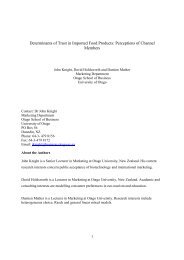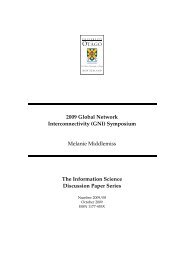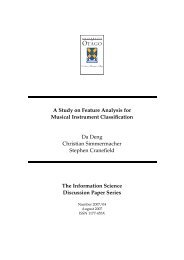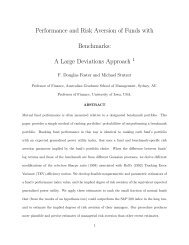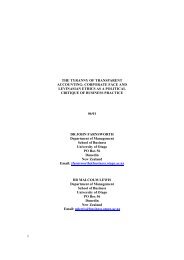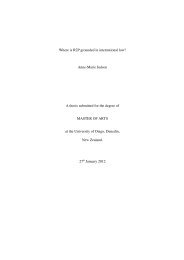University of Otago Cadastral - Otago University Research Archive
University of Otago Cadastral - Otago University Research Archive
University of Otago Cadastral - Otago University Research Archive
Create successful ePaper yourself
Turn your PDF publications into a flip-book with our unique Google optimized e-Paper software.
In theory, the introduction <strong>of</strong> a cadastral system is not supposedto create new interests in<br />
land, nor abolish existing ones. It is only supposedto ascertain and record the interests<br />
recognised by the land tenure arrangements. Reform <strong>of</strong> an existing system<br />
should be<br />
expected to have even less effect on the land tenure arrangements. However, components<br />
in a systemic relationship respond to changes in neighbouring components. The cadastral<br />
system is part <strong>of</strong> the overall land tenure system. <strong>Cadastral</strong> reform is designed to improve<br />
the operation and efficiency <strong>of</strong> the cadastral system. It therefore affects the administration<br />
<strong>of</strong>, and transfer <strong>of</strong> interests in land. It may lead to more secure title or faster land<br />
transactions. More secure title and easier transactions may<br />
translate into more economic<br />
activity on the land. It therefore provides more incentive and opportunitiesfor landowners<br />
to invest, with pecuniary advantages. These in turn may translate into income<br />
redistribution and changes in power relationships derived from the ownership<br />
<strong>of</strong> land.<br />
In practice, therefore, changes in cadastral arrangement do affect the land tenure<br />
arrangements. This is in spite <strong>of</strong> declarations that r e g i s t r<strong>of</strong> a ttitle i o nis a system<br />
<strong>of</strong> record<br />
and not a new substantive land l a w [Dowson and Sheppard 1956, 72]. In fact, land<br />
registration laws have been used to effect changes in property rights and [ t h Torrens e<br />
system was intended] to get rid <strong>of</strong> much <strong>of</strong> the obscurity and complexity<br />
inherent in<br />
English land l a w [Simpson 1976, l68]. Simpson suggests that title registration i s<br />
particularly needed in those countries where it is necessary to unify the law applying to<br />
those titles granted by Government in the days<br />
<strong>of</strong> colonial rule and those titles which have<br />
developed under customary law (or in spite <strong>of</strong> i t ) . Reform <strong>of</strong> the cadastral system should<br />
therefore consider possible effects on the land tenure system. This paper argues that some<br />
<strong>of</strong> these changes are not necessarily positive in developing countries.<br />
3 Modernising Customary Land Tenure<br />
3.1 Customary<br />
Land Tenure<br />
Customary land tenure is the system <strong>of</strong> land holding<br />
and land use which derives from the<br />
operations <strong>of</strong> the traditions and customs <strong>of</strong> the people affected. Customary<br />
law derives<br />
from the accepted practices <strong>of</strong> the people and the principles underlying such practices.<br />
Another source <strong>of</strong> customary law is from rules made by chiefs in response to specific<br />
situations, e.<br />
g., draught or war, which once<br />
acceptedby the people become c u s t o m even <br />
after the situation which prompted the rule has passed. In some countries, the colonial<br />
authorities established customary courts and other local authorities which had the power to<br />
5




